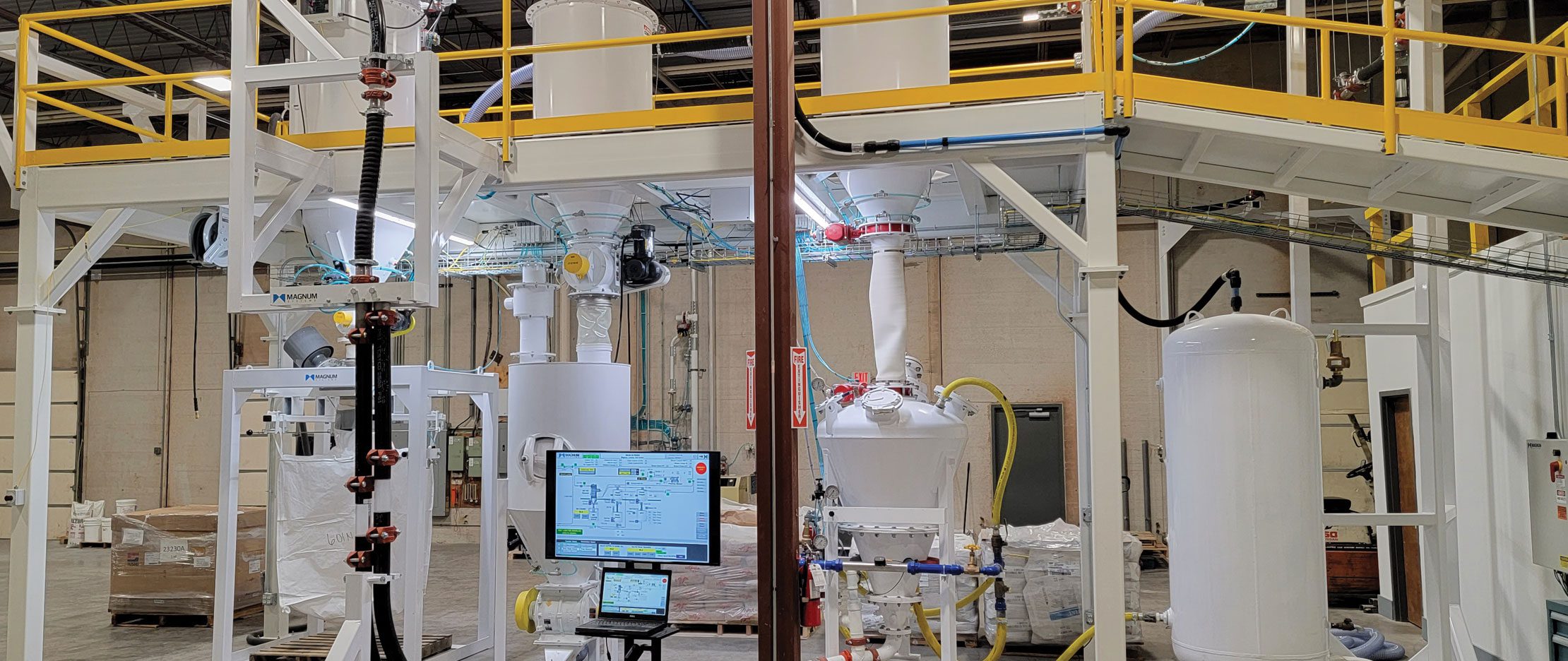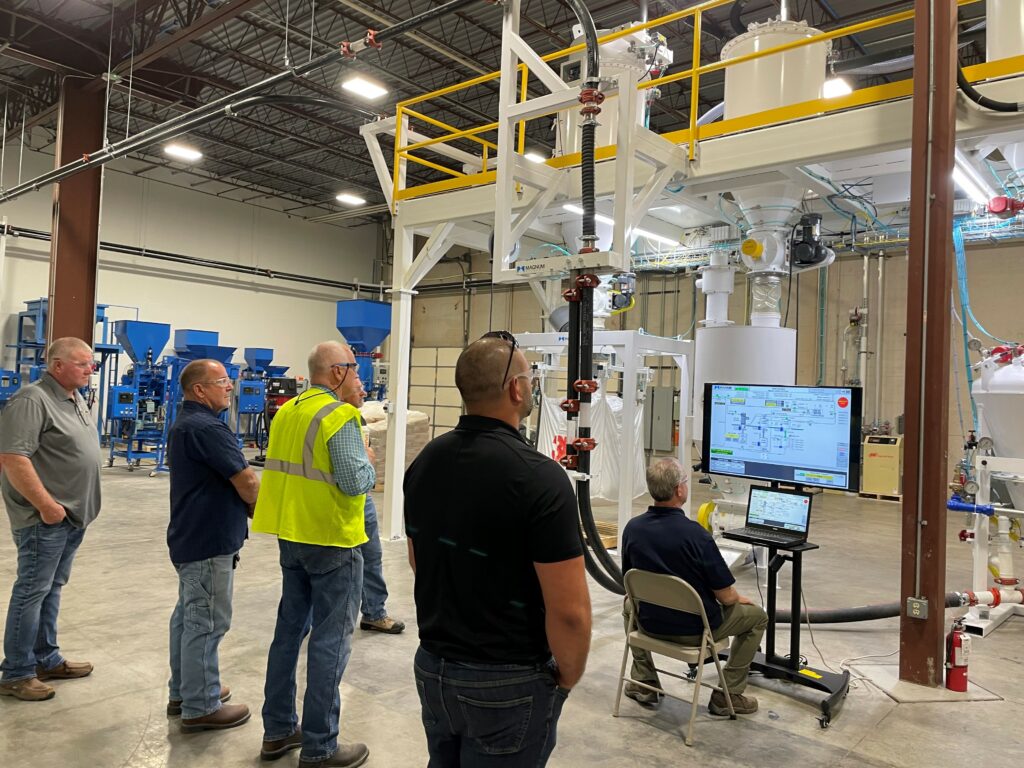

Our test lab has undergone a significant transformation, spearheaded by Dave Wollenberg, which has enhanced our testing capabilities to offer more comprehensive and efficient services to our clients. Our focus has always been on pneumatic conveying and packaging systems. However, with the relocation of the test lab to our Lenexa facility, we've managed to consolidate these capabilities under one roof. This was a strategic move aimed at improving our efficiency and customer experience, eliminating the need for clients to travel between our old facilities in Kansas City, Kansas, and Parsons, Kansas.
"The original goals of the test lab were to consolidate the testing capability so that a customer can come in here and see both types of testing, whether it's pneumatic conveying or packaging, and do both of those tests here," Dave explains.
Test Lab Requirements and Goals
Before scheduling a test, we require specific information to understand what we're testing and how we will approach it. Safety is paramount, and we require a Safety Data Sheet (SDS) for handling the test materials. We also need to discuss return shipping arrangements for disposing of the material after the test.
The ultimate goal of our test lab is to instill confidence in our clients. We want them to know we have the knowledge and capacity to solve their problems. We collect data, summarize it and put it into reports to ensure we're picking the right equipment or system to solve the issues at hand.
Types of Tests We Perform
Our test lab is equipped to perform a variety of tests, ranging from material evaluation and packaging tests to pneumatic tests. Magnum is also prepared to assess future capabilities and improvements to our services.
In our material evaluation, we look at several factors like adhesiveness, cohesiveness, degradability, bulk density and more. We perform sieve tests to understand the distribution of the material or particle size, which is crucial information for systems like dense phase conveying or packaging.
"Anytime you pneumatically convey something, you're going to degrade it to some degree," Dave points out.
Additional Testing Parameters and Reporting
When conducting tests, it's essential to clearly outline our objectives, enabling everyone to focus on the same end goal. For instance, take a look at a packaging test report. This type of report outlines what we did and how we executed the test. In one instance, we tested a smaller package for Wagner’s LLC, which was challenging since our gravity net weigher (GN) is typically designed to handle heavier weights. The report outlines the type of machine we used and the material we ran through it. It also provides details on the measurements and fill times. Should there be any unusual or unique changes to the machine, these will be documented to assist our applications engineering team when the customer decides to place an order.
Dave also typically runs a permeameter test on all materials for pneumatic conveying tests. This type of test shows us whether the material is fluidizable and/or permeable, which helps narrow down what type of conveying is suitable for their material.
Pneumatic Testing Capabilities and Parameters
In Magnum’s test lab, we have the capability to carry out various pneumatic tests. For example, we can conduct pressure and vacuum tests in dense phase conveying. Our current setup allows for pressure testing only, though we could set it up for vacuum testing if necessary. When performing tests, we consider the distances that we can convey through, which in our lab, are represented by either the short loop or the long loop. With a difference of about 150 feet and an additional four elbows, the long loop presents a greater challenge that should simulate most pneumatic requirements.
"This gives you a 3D view of the system we have in place," Dave explains. "We have a filter receiver here and two hoppers up here. Each hopper supports a different type of conveying. This is the dense phase hopper. This is the dense phase vessel, and then we've got another hopper down here that we drop the material into and then feed it out of and back into the system. Both systems use the exact same convey lines."


Understanding Material Characteristics and Choosing the Right Conveying Method
Understanding the characteristics of the material to be conveyed is crucial. For instance, do we need to be concerned about material degradation or abrasiveness? For materials that may degrade more if run in a dilute phase, dense phase conveying is a better choice since it operates at lower velocities. Similarly, for abrasive materials, such as sand, dense phase conveying can help protect the system by reducing wear and tear. However, it's important to note that not all abrasive or large particle-size materials are suitable for dense phase conveying.
"In dense phase conveying, the speed is similar to how fast you walk," Dave says. "In dilute phase conveying, it's more like the speed at which you drive your car."
Future Capabilities and Improvements
Our intention is to constantly improve our services and expand our capabilities. Currently, we are working on implementing the APO dual and enhancing our bulk bag unloading and bag dump capabilities. In the future, we plan to facilitate conveying packaging equipment, providing yet another service layer for our customers.
"One of the things we're trying to do is make sure everyone understands what we're working on. We're all in this together, and if we all understand what we're doing and we're all rowing the boat in the same direction, we have a chance to make sure we send a quality product out the door that's going to accomplish what we want it to accomplish," Dave concludes.
Magnum’s Test Lab Role in Future Growth
Our test lab has come a long way. We've enhanced our capabilities, smoothed our processes and continually sought ways to improve our services. We aim to provide a professional and impressive service and are committed to making our testing procedures as clear and comprehensive as possible.
"The ultimate goal of the test lab is to provide revenue. So, we would like to use this as a tool to help us partner with folks and instill a kind of confidence from the customer that those guys, yeah, they know what they're doing," Dave concludes.
Magnum Systems podcast series, AIM!
RELATED POSTS
Special Project Manager Shares Common and Doozy Pneumatic Conveying Challenges
You're Not Going to Fill a Juice Glass with a Fire Hose
Pneumatically Speaking in Terms of Efficiency, Compliance & Safety
Packaging Powder, Pellets and Flakes: How Not to Blow It
Automated Packaging Lines: Wringing Out Every Ounce
Related Post
Why Use a Single-Source Systems Integrator Like Magnum Systems?
What Are the Advantages of Dense-Phase Pneumatic Conveying?
Mastering Integration in Manufacturing with Magnum Systems: A Deep Dive Podcast Episode
The Secrets of Valve Bag Sealing: Expert Insights from Magnum Systems